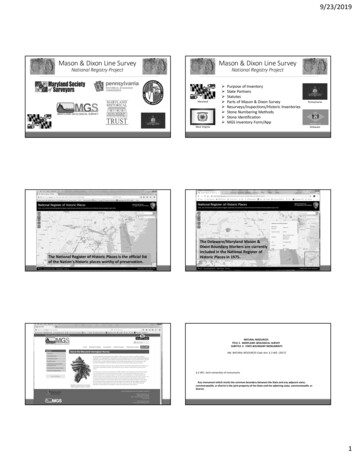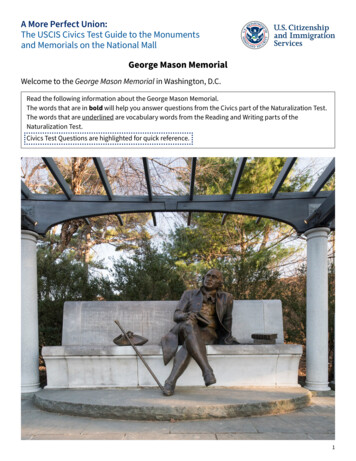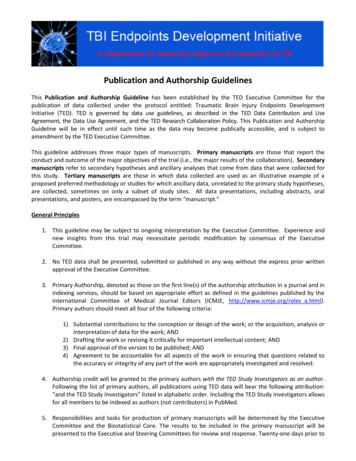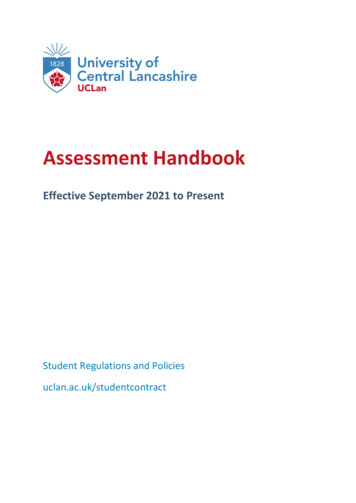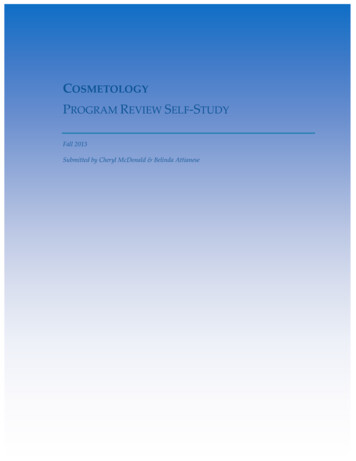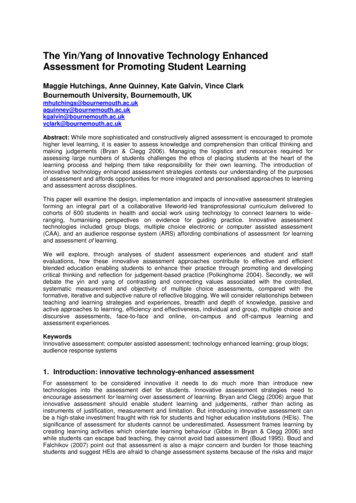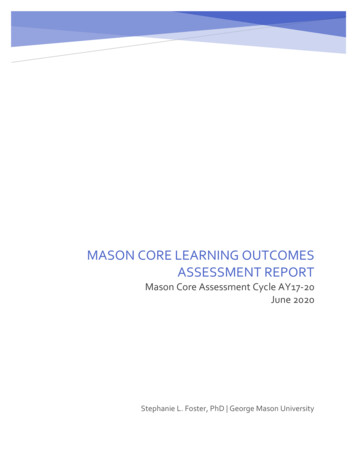
Transcription
DRAFT for REVIEW DO NOT SHAREMASON CORE LEARNING OUTCOMESASSESSMENT REPORTMason Core Assessment Cycle AY17-20June 2020Stephanie L. Foster, PhD George Mason University
OverviewThis report documents the work of assessing student learning outcomes across the MasonCore (general education) program during the period of spring 2017 through spring 2020. Thiswas the first large-scale assessment at George Mason University that used student workproducts to understand learning at the program level; that is, by aggregating results, we canidentify patterns across courses and student populations.This work was supported by the Provost Office, through the leadership of Dr. Bethany Usherand the Office of Undergraduate Education. More than 250 faculty contributed to the workthrough their disciplinary guidance and direct engagement in different pieces of theassessment. Many more faculty and graduate teaching assistants participated in professionaldevelopment activities and in discussion of the results over the three-year period.The report provides information about the purpose, framework, and methods used in thisassessment, followed by summary reports of the assessment process and results for each setof learning outcomes in the Mason Core categories. Rubrics used in the assessment follow inthe Appendix.Descriptions of academic and student support units that provide substantial supp0rt forstudent learning are included in the report. It is important to showcase these units for theirinvestment in the Mason Core.While this report provides summary results for purposes of documentation and sharing withthe university community, it should be noted that in-depth analyses and curriculardevelopment using these results are ongoing with specific programs and units represented inthe report. This work contributes to the continuous improvement of the learning environmentand serves the multiple needs of student learners across the university.Suggested citation:Foster, S. L. (2020). Mason Core learning outcomes assessment report: Mason CoreAssessment Cycle AY17-20. Fairfax, VA: George Mason University.1
AcknowledgementsThere were many people who contributed to this work at many stages. On behalf of theProvost’s Office, the author would like to thank the following individuals for their time andpartnership throughout this assessment process.Contributors to the ReportMelissa Broeckelman-PostBenjamin DreyfusMaoria KirkerSusan LawrenceJessica MatthewsBrian PlattThomas PolkJohn WoolseyCourtney WootenZhicheng ZhangMason Core Committee, AY18-20 MembersBethany Usher, Associate Provost for Undergraduate EducationAbena AidooDominique BanvilleMelissa Broeckelman-PostLorelei CrerarChris DiTeresiCheryl DruehlKelly DunneRebecca EricsonJane HooperJason KinserTamara MaddoxLaura PomsShelley ReidBenjamin StegerKamaljeet SangheraMatthew SchererMara SchoenyGarry SparksAli WeinsteinPeter WinantCourtney WootenBecky EricsonGwen FondufeCynthia FuchsSteve GerberKimberly HoffmanJane HooperSheri HuertaBeth JohnsonJason KinserLisa KochMaryjo KolzeMisty KrellGiuseppina KysarMattiettiMichelle LaFranceMargaret LamLucie LiTamara MaddoxHelen McManusSam MeddisSherrice MojganiLincoln MullenErin MurdochEllen O'BrienKara OakleafBrian PlattLaura PomsCortney RinkerStephen RobertsonGreg RobinsonMark RudnickiKammy SangheraFaculty Working GroupsBelal AbdelfattahJan AllbeckHeather AndersonLeila AustinPatricia BoudinotNathan BurtchTheresa CalcagnoMichael ChangChuck CiorbaKaren CrossinLaura D'AntonioCarrie Ann DelaneyChris DiTeresiBenjamin DreyfusChris ElzeyMegan Erb2
Vanessa SchulmannBlake SilverMark SnyderSheri SorvilloGarry SparksKen StrazzeriHongmei SunJohn TurnerJoris van der HamAli WeinsteinTom WoodJohn WoolseyAnna WyczalkowskiAoi YamanakaAndy YoderCaitlin DunganJustin EvansDoug EymanMosissa FayissaLourdes FernandezBrian FitzpatrickKerry FolanCynthia FuchsSaiid GanjalizadehRosalind GannVeronica Garrison-JoynerKris GebhardHarold GellerSteve GerberDavid GerlemanAriel GoldenthalJohn GuthrieMiriam GyimahAnna HabibLeigh HarrisonPaul HaspelAmy HasselkusSharrell Hassell-GoodmanKimberly HoffmanVirginia HoySeth HudsonSheri HuertaJoan HwangKatherine Hyatt-HawkinsEmily IharaKristin Johnsen-NeshatiJoyce JohnstonYoung A JungBrittany KerfootYounsung KimMaoria KirkerLisa KochMJ KolzeMaction KomwaMisty KrellGeorge KueppersAjay KulkarniGiuseppina KysarMattiettiElizabeth LangEric LarsonHeidi LawrenceSusan LawrenceArion LeahighAndrew LeeStephanie Lessard-PilonStephanie LiberatoreLisa ListerSamaine LockwoodRon MahabirThunyapong MahapolAndie MalterudLori MandableJonathan MarineMuffarah MarrJessica MatthewsLaura McCloskey WolfeJoseph McGuinnessHelen McManusSam MeddisAnne MelvilleJennifer MessierKent MillerNadiatou MiningouJoshua MurphyAnton MurrayRichard NanianReviewersAdebanke AdebayoPouyan AhmadiAbena AidooAmal AmirehHeather AndersonAnthony ArcieroFernando ArteagaOmar AzizAmy BangerterKimberly BanksTim BarzditisLisa BillinghamBonnie BoazMelissa Broeckelman-PostNate BrophySyeda BuchwachErin BushTetyana BychkovskaJames CarrollBenedict CartonWan-Lin ChangAnn Cavazos ChenAsma ChaudharyHyunyoung ChoLori ClarkAndrew CoteKaren CrossinLaura D'AntonioCharles DavidsonAnneke DeLuyckerKaushik Reddy DendiRutledge DennisMegan DevineChris DiTeresiBenjamin DreyfusCheryl Druehl3
Esther NoltonLuanne NordenJennifer NorthKara OakleafHenrietta OkaforAdeyemi OlanrewajuSamson Olaitan OmoleBen OrlandoAyodeji OtusanyaTom OwensCorrie PaeglowLuis PalaciosAudrey PettibonLisa PhotosRobert PierceTom PolkNagendra Prasad PrakashVictor ProvostAndrew PyleJohn RajkovichNiloofar RamezaniPsyche ReadyPrabhavati ReddyAllison RedlichMegan ReicheltJonathon RepineczMatt RiceSarah RicklessGreg RobinsonMark RudnickiRanda SaadKamaljeet SangheraCathy SaundersJames SavageSameer SavkarMargaret ScolaroJohn SchulerSusan SchulzeDeb SivignySheri SorvilloShvetha SoundararajanNicole SpringerCristiana StanBriana StewartPeter StreckfusHeather Streckfus-GreenHongmei SunAnkita TapadiaAachal ThapaCigole ThomasAnirudh TunuguntlaJohn TurnerEmily TuszynskaDeepanshu VermaHollie VillanuevaJai Janak VoraJohn WalterAli WeinsteinDominic WhiteJohn WoolseyDouglas WulfYoung YungKatherine ZukeriSpecial ThanksE. Shelley ReidDirector for Teaching Excellence, Stearns Center for Teaching and LearningAllison Sedon, MPH ‘20Research AssistantKrista Shires, MS ‘19Curriculum Coordinator, Office of Undergraduate EducationThank you to the Mason CommunityOur sincerest appreciation to all of the deans, associate deans, chairs and directors, associatechairs, and course coordinators who supported this assessment process through positivecommunication and encouragement for your faculty. Your commitment to student success isclear!4
Table of ContentsOverview . 1Acknowledgements . 2The Mason Core and Expected Learning Outcomes . 7The Mason Core . 7The Honors College: Integrative Core. 8Purpose, Framework, and Method for Assessment . 9Purpose for Assessment . 9Assessment Framework . 9Assessment Method . 10Data Used in the Assessment . 13Core Category Assessment Reports . 15Arts. 16Critical Thinking (Synthesis and Capstone) . 27Global Understanding . 44IT & Computing . 57Literature . 68Natural Sciences.77Oral Communication . 89Quantitative Reasoning. 98Social and Behavioral Sciences. 114Western Civilization and World History . 123Written Communication . 132Written Communication in the Major .151Indirect Assessment: Surveys . 164Graduating Senior Survey 2016 – 2019: Selected Results on General EducationCompetencies . 165Faculty Participant Survey. 169Academic and Student Support Units .172Learning Assistants Program .172University Libraries. 173Writing Across the Curriculum. 175The University Writing Center .1765
Conclusions .178Appendix A: Mason Core Assessment Plan AY17-20 . 183Appendix B: Mason Core Assessment Schedule, AY18-20 . 188Appendix C: External Reporting Requirements . 189Appendix D: Assessment Rubrics . 191Appendix E: References . 2196
The Mason Core and Expected Learning OutcomesThe Mason CoreThe Mason Core is a set of required courses that create the foundation of a Masonundergraduate degree. The Mason Core provides a breadth of liberal education courses,complementing the depth of knowledge and skills in the majors and minors. The Mason Corehelps a student become a Mason Graduate: an engaged, well-rounded scholar who is preparedto act.The Mason Core is divided into three sections: Foundation, Exploration, and Integration.Foundation courses establish key knowledge and skills needed for academic success.Exploration courses provide a breadth of learning across the university. Integration coursesinclude upper-division courses that are designed to integrate knowledge and skills learnedfrom Foundation and Exploration courses into learning in the major. Courses in each categoryare guided by specific student learning outcomes that are assessed on a regular basis throughthe student academic experience.Students take courses that are approved by the Mason Core Committee for each category,transfer in an approved course, or earn an appropriate waiver.Course CategoriesFoundation Courses Written Communication--Lower Division (ENGH 101, 3 credits)Oral Communication (3 credits)Quantitative Reasoning (3 credits)Information Technology and Computing (3 credits)Exploration Courses Arts (3 credits)Global Understanding (3 credits)Literature (3 credits)Natural Science (7 credits)Social and Behavioral Science (3 credits)Western Civilization or World History (3 credits)Integration CoursesWritten Communication--Upper Division (ENGH 302, 3 credits)Writing-Intensive (3 credits*)Capstone or Synthesis (3 credits)Total: 40 creditsLearning OutcomesLearning outcomes are created and periodically revised by the Mason Core Committee incollaboration with the faculty. All courses that are approved for the Mason Core are expected7
to address the relevant learning outcomes through aligned course learning activities andassessments. Learning outcomes are the basis for assessment of student learning in the MasonCore courses. In this report, learning outcomes are listed in each report for the respectivecategory.The Honors College: Integrative CoreTaught by faculty from across the University, the Honors College provides exceptionallymotivated students an alternative to the Mason Core. The College’s integrated curriculumallows students increased opportunities to pursue undergraduate research, minors, internshipsand study abroad courses. HNRS courses are inquiry-driven, discussion-based seminars thatstress the collaborative nature of learning and act as a forum for students to practice thecritical reading, writing and speaking skills associated with undergraduate research.Starting in their first semesters on campus, Honors College students are challenged to identify,articulate, and evaluate multiple perspectives on questions of cultural, scientific, or globalsignificance and to consider evidence that broadens their understanding and challenges theirbeliefs. In their Foundations course (3-4 credits), students learn skills for identifying andpursuing lines of scholarly inquiry and placing them in a larger civic context by using evidencebased reasoning and exploring multiple perspectives. In their first semester, Honors Collegestudents are introduced to and practice the skills needed to conduct a literature review,identify enduring questions, consider civic and scholarly stakeholders, and propose a process,budget and timeline for future action or research.Students go on to hone their inquiry skills through a series of discussion-based seminars thatstress collaborative learning, critical reading, writing and thinking: Inquiry in the Arts,Humanities, & Social Sciences (12 credits). In their Civic Engagement course (HNRS 260),students use these skills to identify pressing issues of public and community concern andexplore their corresponding civic duties and responsibilities. In HNRS 360, students addresscomplex problems in a team-based environment involving several scholarly approaches:Multidisciplinary Challenges. At both the 200 and 300-levels, students have an option to fulfillcourse requirements by taking an experiential learning course.For more information about the Honors College Core Curriculum, lum8
Purpose, Framework, and Method for AssessmentThis report documents the work of many individuals and programs across the university toconduct an assessment of student learning outcomes for the Mason Core curricular program.Although there has been ongoing assessment of various aspects of the Mason Core for morethan 30 years, this was the first attempt at a large-scale assessment of learning by directreview of student coursework. This strategy was developed to align with best practices inhigher education assessment and facilitate faculty engagement throughout the process.Purpose for AssessmentAssessment is the systematic process of collecting, evaluating, and using information todetermine how well we are meeting our goals. Assessment informs meaningful dialogue anddecision-making about how the university can improve its programs and services to supportstudent success. Assessment can help faculty improve their own teaching practice and makeinformed and collaborative decisions about the curriculum. Assessment and the use of resultsfor improvement are required for Mason’s regional accreditation with the SouthernAssociation of Colleges and Schools Commission on Colleges (SACSCOC); specializedaccrediting agencies such as ABET and AASCB; and the State Council of Higher Education forVirginia (SCHEV).Assessment FrameworkGuiding Questions and Level of AnalysisThis assessment focused on addressing two substantive questions: To what extent are students achieving the general education (Mason Core) learningoutcomes?How well are Mason Core courses designed to help students to achieve the learningoutcomes?Additionally, because the assessment strategy used locally developed tools for the first time, itwas important to ask a methodological question: How effective is a common rubric in assessing learning of broad outcomes acrosscourses and disciplines?Faculty shared materials and student work samples from course sections to support a programlevel assessment. The assessment focused on understanding student learning outcomes acrosscourses in a category, and was not an evaluation of any individual course or instructor.Although materials were collected at the end of a semester and the review completed in thefollowing semester, it is hoped that faculty consider this to be a form of formative assessment;9
the information from this assessment should be used to make ongoing changes to the MasonCore as well as course curriculum. The work should also be repeated at regular intervals topromote an ongoing assessment process.Collaborative ProcessThe assessment strategy was led by staff in the Provost Office in collaboration with Masonfaculty, course coordinators, and department chairs. Faculty have been involved in all stages ofthis project: Planning: Chairs identified key faculty, such as course coordinators and leaders forMason Core courses to share information about their courses and students, identifyquestions and concerns, and join working groups to develop assessment rubrics.Faculty working groups assisted with planning, selected and developed assessmenttools, and provided important disciplinary guidance for the assessment Assessment Activities: All faculty teaching Mason Core courses were encouraged toparticipate in the pre-assessment professional development workshop, and wereexpected to submit a portfolio for their course during the assessment semester. Facultywho participated in those activities were awarded a stipend or professionaldevelopment funds for their efforts. Reviewing: All faculty teaching in the Mason Core were invited to participate asreviewers of student work samples. Reviewers were trained on reading student workagainst the relevant rubric, and received compensation for their efforts. Post-Assessment: All faculty were invited to participate in a post-assessment meetingin the semester following the assessment. In these meetings, faculty reviewed theresults, discussed implications for their courses and programs, and maderecommendations for revision.Assessment MethodVALUE Rubric AssessmentThe VALUE model was chosen for the Mason Core assessment. VALUE (Valid Assessment ofLearning in Undergraduate Education) rubrics were developed by the Association of AmericanColleges and Universities (AAC&U) beginning in 2008 to provide college campuses with toolsto conduct direct assessment of student learning using authentic student work. The rubricswere developed to assess learning over the course of the college experience, and offereddetailed developmental milestones for 16 sets of essential learning outcomes. Mason has usedthe Critical Thinking VALUE Rubric (2009) to assess student work several times since 20101.1See Critical Thinking Trends 2010-2014, sults/10
VALUE rubrics have been increasingly used in higher education as an authentic, evidencebased approach to assess key learning outcomes across diverse institutions and studentpopulations (McConnell & Rhodes, 2017). Rubrics communicate the expectations for learningto students, and provide a framework for faculty to guide course and curricular decisions.Rubrics have the potential to serve as institutional frameworks for teaching and learning acrossdisciplines (National Leadership Council for Liberal Education & America’s Promise, 2008).Each VALUE rubric identifies key learning outcomes for each area (e.g. critical thinking) andprovides four performance indicators for each outcome. The performance descriptors areintended to span a full college experience, from first-year through capstone. AAC&Uacknowledges that “learning is often messy” (McConnell & Rhodes, 2017, p. 14), and rubricassessment is imperfect. This model allows the rubrics to be used for students at all levels andacross many kinds of work products, thus capturing much of the “messiness”. Reviewers aretrained to reach agreement on the performance of each learning outcome as evidenced in eachstudent sample. AAC&U claims high content and face validity of its rubrics (Rhodes, 2016), aswell as moderate to high reliability ratings (Finley, 2012; McConnell & Rhodes, 2017). Gray,Brown, & Connolly (2017) established the validity of the Quantitative Literacy rubric formeasuring student performance for signature projects (typically, graduating seniors), andconfirmed the importance of intensive norming/calibration training to insure high inter-raterreliability.In 2017, AAC&U, in collaboration with the State Higher Education Executive Officersassociation and the Multi-State Collaborative, published a report of findings from a large-scaleassessment using the VALUE rubrics for written communication, quantitative literacy, andcritical thinking (McConnell & Rhodes, 2017). The study focused on data from the review ofmore than 21,000 work samples from 92 public and private two- and four-year colleges anduniversities across twelve states. Reviewers received extensive online training, bothsynchronous and asynchronous, and engaged in a rigorous norming process to insure validratings.2 This study represented the first time that the rubrics were used on this scale, and thedata can be used to benchmark local assessments. In this report, data from 4-year publicinstitutions in the McConnell & Rhodes study are provided as comparison for Masonassessments in critical thinking, written communication in the major, and quantitativereasoning.Mason faculty chose to adopt the VALUE rubrics for critical thinking, written communication,and quantitative reasoning. The faculty working group for Global Understanding chose toadapt the Global Learning VALUE rubric, creating a modified version that they thought betteraligned with the Mason Core outcomes. For Mason Core categories for which there was noexisting VALUE rubric (Arts, Literature, Social and Behavioral Sciences, Natural Sciences,Western Civilization/World History, and IT & Computing), working groups developed rubricsbased on the principles and patterns of the VALUE rubrics. This strategy contributed to a senseof consistency across the Mason Core program.2The author of the current report, Stephanie Foster, participated as a reviewer for the Critical Thinking VALUERubric in the McConnell and Rhodes study.11
In a few cases—specifically, English Composition and Oral Communication—VALUE rubricswere not used, as there were existing assessment tools that aligned with disciplinary andcourse-specific outcomes. However, these t0ols were developed with the VALUE rubrics inmind, and can easily be mapped to the VALUE rubrics for Written Communication and OralCommunication, respectively.Assessment ProcessThe assessment cycle featured three main emphases: assistance to faculty with assignmentdesign and alignment to support Mason Core student learning outcomes, direct assessment ofstudent work, and use of results for improvement. There were five stages:1. Communication and Planninga. Communications were handled through in-person meetings at key leadershipmeetings, and through advance emails with deans, directors, and chairs. Awebsite provided detailed information on all aspects of the initiative.b. Working groups were created 1-2 semesters in advance to plan for eachassessment. Working groups comprised Mason Core faculty, coursecoordinators, and subject librarians. Working groups created rubrics andprovided disciplinary expertise.2. Data Collectiona. Mason Core faculty were asked to participate if they were teaching in theassessment semester. Faculty were asked to:i. participate in a 2-hour pre-assessment workshop at the beginning ofsemesterii. prepare a course portfolio comprising the syllabus, one assignment, and3-5 randomly selected student work samplesb. Faculty submitted assessment materials through a secure Blackboardorganization. Periodic reminders were sent through Blackboard at key timesduring the semester. All materials were due by the last day of the semester.c. Faculty were provided with randomized enrollment lists with identified studentswhose work was requested for use in the assessment. Faculty were asked tosubmit the samples with student names.3. Review of Student Worka. Work samples were coded, removing student names as well as course andinstructor information.b. Faculty volunteer reviewers were given instructions and a pre-review sessionassignment.12
c. Reviewers convened for a full day (9:00 to 5:00), including a 3-hournorming/calibration session, lunch, and five hours to review student work.Ratings were collected using a Qualtrics online form.d. Inter-rater reliability was assured for each of the Mason Core reviews through anintensive reviewer norming process. Each sample was reviewed twice. Samplesthat received discrepant scores were reviewed by a third trained reviewer, andthe outlier was replaced.4. Data Analysis and Reportinga. Rubric data were merged with student demographics and course information.Analyses were conducted based on the appropriateness of the data and inresponse to faculty requests.b. Brief reports were created to share initial results.5. Post-Assessment Discussionsa. Faculty were asked to participate in a one-hour post-assessment meeting in thesemester following the assessment. Meetings focused on results of theassessment, and use of results to promote improvement.b. Targeted meetings were held with faculty groups, academic units, and theMason Core committee to discuss how to use results for curricularimprovement.Data Used in the AssessmentBoth direct and indirect assessment methods were used to address the substantive questions.Data supporting these methods were collected and analyzed for this report, and are outlinedbelow. Table 1 outlines the assessment questions and supporting data used in this report.Direct Assessment1. Course Portfolio: Course syllabus, an instructor-selected assignment prompt(submitted through Blackboard)2. Work Samples: 3-5 randomly selected individual* student work samples from theassignment submitted in #1Indirect Assessment3. Student Survey: End of semester survey administered online and focusing on studentperception of their learning in the course*Team-based samples were collected but not used in this assessment; a separate method and analysis will benecessary.13
4. Faculty Survey: Anonymous online survey administered after participation in a keyassessment activity, use of assessment experience, changes made to instruction, andattitudes about assessment5. Banner Course Data: Student- and course-level data used as analytical variablesTable 1. Assessment Questions and Strategies with Supporting DataQuestionSub-QuestionsHow are coursesdesigned to addressthe Mason Corelearning outcomes?How well do the syllabus,assignment descriptions, andactivities support students inachieving the learning outcomes?To what extent arestudents learning?How are faculty usingassessment experienceto improveinstruction?Information aboutMason Core coursesAssessment Strategyand Data UsedSyllabus andassignment reviewLevel of AnalysisHow well does the coursesyllabus communicate tostudents the Mason Corelearning outcomes?How well are studentsperforming on the learningoutcomes?Syllabus reviewBy categoryStudent work samplesWhat are students’ perceptionsof their own learning?--MC Student Survey--Graduating SeniorExit Survey relevantitemsAggregated studentperformance data;analysis by keydemographicvariables--by category--disaggregated asapplicableHow are faculty using theirexperience in facultydevelopment workshops, rubricdevelopment working groups,review sessions, and portfoliosubmission to improve theirteaching practice?Courses (5-year trend data:AY15-19) Number of courses andsections in each category Course enrollment Final grades distribution DFW ratesStudents: First-time Freshman/Transfer admits Gender Race Major Course GradeMason Core FacultyParticipant SurveySummaryBanner Course DataBy categoryDisaggregated byschool/college,department, or courseas appropriateBanner Course DataUsed as analyticalvariables for specificanalysesBy category14
Core Category Assessment ReportsThe following twelve sections document the ass
Natural Science (7 credits) Social and Behavioral Science (3 credits) Western Civilization or World History (3 credits) Integration Courses Written Communication--Upper Division (ENGH 302, 3 credits) Writing-Intensive (3 credits*) Capstone or Synthesis (3 credits) Total: 40 credits Learning Outcomes
